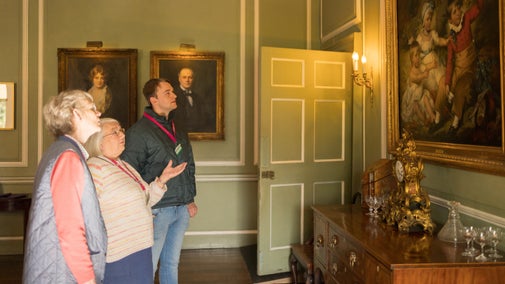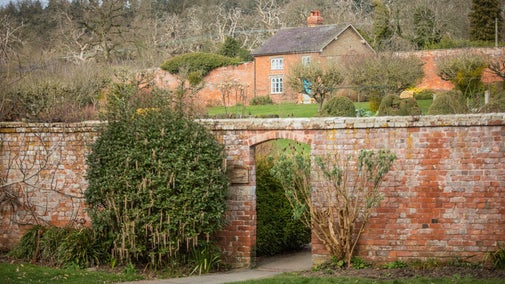
Discover more at Croft Castle and Parkland
Find out when Croft Castle is open, how to get here, things to see and do and more.

Croft Castle was noted in the Domesday book in 1086 and the Croft family have fought to keep their home ever since. In the castle you can uncover stories about the key members of the family who played their part in influencing British political and military history.
On your visit you’ll discover stories of Sir Richard Croft, who fought with his Croft army during the Wars of the Roses, and the Tudor Sir James Croft who was imprisoned in the Tower of London during the Wyatt rebellion and tortured because he wouldn't betray Elizabeth I.
Learn about when the Crofts lost their home in 1746 and eventually bought it back 177 years later. You can see the changes the Somerset Davies and Kevill Davies families made to the interiors and estate at Croft whilst the Crofts were away.
Find out about William Croft and the Civil War and what happened to the castle during this time and move right up to the twentieth century as research continues to help share more stories of Croft and its inhabitants.
Although the hall looks old, it is one of the most recent additions to the castle. It was added by the Johnes family who had bought Croft Castle from the Crofts in 1746. It is thought that this space would have been open for carriages to sweep straight into the courtyard, and that the actual entrance was on the West front, where you can still see the avenue of Spanish chestnut trees planted over 350 years ago.
Take a walk along the gallery to view family portraits dating back to Sir Herbert Croft who was created first Baronet in 1671. The Croft family were first recorded at Croft in the Domesday book of 1086 when Bernard de Croft was settled here. Through the windows you can catch a glimpse of the inner courtyard.
The dining room has witnessed many moments of homecoming, celebration, power and struggle in twentieth century Croft family history. The chairs you will see are in the style of Thomas Chippendale, along with a nineteenth century Cumberland dining table. The Venetian window and the screen of columns in the room were intended to separate the area where food would be served from the main body of the room.
In 2018 an oil painting by John Constable of Elizabeth Lewis, the second wife of Rev. Sir Herbert Croft, 5th Baronet, appeared at auction and was purchased by the Croft Trust. The painting has been loaned to Croft and hung in the Dining Room ready to be discovered on your next visit.

The thick, majestic oak walls give this room its name. Architect Thomas Farnolls-Pritchard painted over these walls with white to conceal the dark woodwork, and then set about designing plasterwork to match. The ceiling design includes a trailing vine with four roundels containing musical instruments and trophies.
Renovations in 1913 made the room much more comfortable and brought the whole castle into the twentieth century. New designs and alterations were created by Walter Sarel, who also installed electricity and central heating. Large sash windows along the south side open up to views of the countryside.
The Blue Room is decorated with panelling that is said to have been recycled from Stanage Park in Radnorshire. The panels were painted with a 3D effect by Thomas Farnolls-Pritchard who designed the iron bridge and Ironbridge Gorge. They were restored in the 1960s to remove damage caused by the school desks belonging to the children of St. Elizabeth’s school that were evacuated to the castle during the Second World War.
This room was used for entertaining, social gatherings and relaxation. Today, you can have a go on the piano. The Saloon is the largest room in the castle, and the panelling is early Georgian, like that in the Oak Room.

Many of the books in this room belonged to Sir Herbert Croft, 5th baronet, nicknamed ‘The Dictionary Maker’. In the display case you will see a very early copy of Samuel Johnson’s dictionary. Sir Herbert covered the dictionary with his own notes and wanted to publish his own improved version, but didn’t raise enough support.
The library also has books containing compositions by Dr William Croft (1678-1727), the organist of the Chapel Royal. He is most famous for his funeral anthems played at the funeral of Queen Anne and every Royal funeral since.
You will notice a very curious fireplace in this room surrounded by rare transfer-printed tiles by Sadler and Green from the 1760s. However, the fireplace is false and the wall behind it was not added until 1913. Before that, this room formed the end of the gallery and it was possible to look all the way down the corridor to the Oak Room. Look out for the outline of the old archway on the other side of this room as you walk around.
This room is named in honour of the Austrian Ambassador Albert Count von Mensdorff-Pouilly-Diestrichstein. The Ambassador was due to visit Croft in the summer of 1914 and this room was painstakingly prepared for his stay.
However, on 28 June 1914 the heir to the throne of Austria Hungary Archduke Franz Ferdinand were assassinated. This triggered the chain of events that led to the start of the First World War. The Ambassador and his would-be British hosts were now on opposing sides. The Austrian Ambassador left Britain on 12 August 1914 and never made his planned visit to Croft.
The room you see today was decorated by a cousin of the present Lord Croft, Edward Croft-Murray. He was Keeper (Director of the department) of Prints and Drawings at the British Museum for 20 years. He selected the wallpaper and friends were entertained in this room by string quartets. The chimneypiece is another fine example of the work of Thomas Farnolls-Pritchard and the gold embossed overmantel mirror above was created by Thomas Chippendale.
The ground floor of the castle is fully accessible via a ramp which staff can put out for wheelchair users, however there is no step-free access to the first floor.
If you or someone in your party has limited mobility, we have installed a 360° interactive virtual tour on the ground floor of the castle. This tour shows all areas of the building and includes videos of our staff and volunteer who will tell you more about the building’s history. Please speak to a member of staff or volunteer if you would like to know more about our virtual tours.
Large print guides and braille guides are available in the house and access maps can be picked up from visitor reception. Please speak to a member of staff or volunteer if you would like to know more about these options.
To find out more or to book virtual tour session, please call 01568 780246. Visit the access section on our homepage for more information about accessibility across the site.

Find out when Croft Castle is open, how to get here, things to see and do and more.
Discover more about an oil painting by John Constable of Elizabeth Lewis, the second wife of Rev. Sir Herbert Croft, 5th Baronet and how it came to be at Croft Castle.

Find out how the Croft family played their part in major historical events, and how Croft Castle eventually passed to the National Trust.

Discover the garden at Croft Castle, taking in the historic orchard within the walled garden, or listen to the birds in the church garden.
